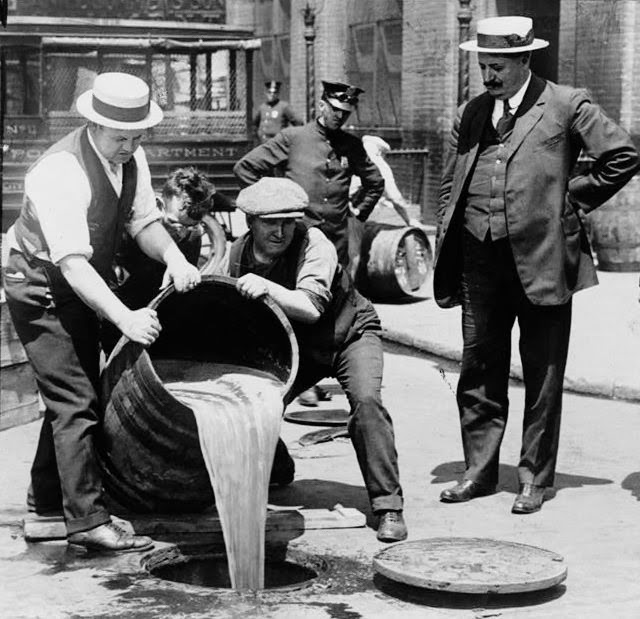|
This Country is Dry
 JANUARY 17, 1919 - The 18th Amendment to the United States Constitution went into effect banning the production, transport and sale of alcohol. It did not, however, ban the consumption or private possession of alcohol. The amendment was the result of a decades-long effort by the temperance movement, and many states had already enacted prohibition prior to the 18th Amendment. Prohibition was relatively short-lived as the 18th Amendment was subsequently overturned by the ratification of the 21st Amendment only 14 years later. During that time period police, courts and prisons were overwhelmed with new cases, organized crime rose in power, and corruption increased among law enforcement officials. While the intent of the amendment was to decrease alcohol consumption, the effect was to turn hundreds of thousands of otherwise law-abiding citizens into criminals overnight. JANUARY 17, 1919 - The 18th Amendment to the United States Constitution went into effect banning the production, transport and sale of alcohol. It did not, however, ban the consumption or private possession of alcohol. The amendment was the result of a decades-long effort by the temperance movement, and many states had already enacted prohibition prior to the 18th Amendment. Prohibition was relatively short-lived as the 18th Amendment was subsequently overturned by the ratification of the 21st Amendment only 14 years later. During that time period police, courts and prisons were overwhelmed with new cases, organized crime rose in power, and corruption increased among law enforcement officials. While the intent of the amendment was to decrease alcohol consumption, the effect was to turn hundreds of thousands of otherwise law-abiding citizens into criminals overnight.
|
|
Snow, Snow, Snow
 JANUARY 19, 1977 - A strong arctic high over the Mississippi Valley and a Nor'easter over Atlantic Canada combined to send very cold temperatures southward into Florida, and for the first time in recorded history snow fell in Miami. Anyone who slept in that day missed it, as the "Blizzard of '77" was over by 9:30 a.m. and the trace amounts of snow that did fall were not significant enough to make it into the actual weather books. Nevertheless, Floridians seemed ecstatic over the rare event. The Miami News was able to get a special edition paper on the street that afternoon with the headline: "Souvenir edition: The day that couldn't happen. Snow in Miami!" Unfortunately along with the novelty of snow, the freezing temperatures also brought disaster to Florida's agriculture community. The state's citrus and vegetable industries were nearly wiped out, and over 150,000 seasonal workers lost their jobs as a result. JANUARY 19, 1977 - A strong arctic high over the Mississippi Valley and a Nor'easter over Atlantic Canada combined to send very cold temperatures southward into Florida, and for the first time in recorded history snow fell in Miami. Anyone who slept in that day missed it, as the "Blizzard of '77" was over by 9:30 a.m. and the trace amounts of snow that did fall were not significant enough to make it into the actual weather books. Nevertheless, Floridians seemed ecstatic over the rare event. The Miami News was able to get a special edition paper on the street that afternoon with the headline: "Souvenir edition: The day that couldn't happen. Snow in Miami!" Unfortunately along with the novelty of snow, the freezing temperatures also brought disaster to Florida's agriculture community. The state's citrus and vegetable industries were nearly wiped out, and over 150,000 seasonal workers lost their jobs as a result.
|

The ampersand is part of our everyday written language, but did you know that the ampersand was also once part of the alphabet? The history of the ampersand traces back to the 1st century A.D. and the Old Roman cursive when the letters E and T were written together to form a ligature. ("et" is the Latin word meaning "and.") According to historian Geoffrey Glaister, the term ampersand is a corruption of and (&) per se and, which literally means "(the character) & by itself (is the word) and." Traditionally, when reciting the alphabet in English-speaking schools, any letter that could also be used as a word in itself ("A" and "I") was preceded by the Latin expression per se ("by itself"). It was also common practice to add the "&" sign at the end of the alphabet as if it were the 27th letter, pronounced and. As a result, the recitation of the alphabet would end in "X, Y, Z, and per se and". This last phrase was routinely slurred to "ampersand" and the term had entered common English usage by 1837. However, in contrast to the 26 letters, the ampersand does not represent a speech sound and was later dropped from the alphabet. For a more detailed history of the ampersand click here.
|
|
"Once, during Prohibition, I was forced to live for days on nothing but food and water."
-- W.C. Fields
|
Heath is Reading:
by Dennis Prager
|
Historical Archives
Read past editions of our This Week in History newsletter any time in our Archives.
|
Hirschi Law Group, PLLC assists clients with Estate Planning, Probate, Business Law, and Income Tax preparation. To schedule a consultation call: 602/346.3409
|
This Week in History is a weekly newsletter produced by Hirschi Law Group, PLLC. The content shared herein is for information and entertainment purposes only. All photographs, artwork, and original content generated by others featured in this newsletter are the property of the respective copyright owners.
|
|